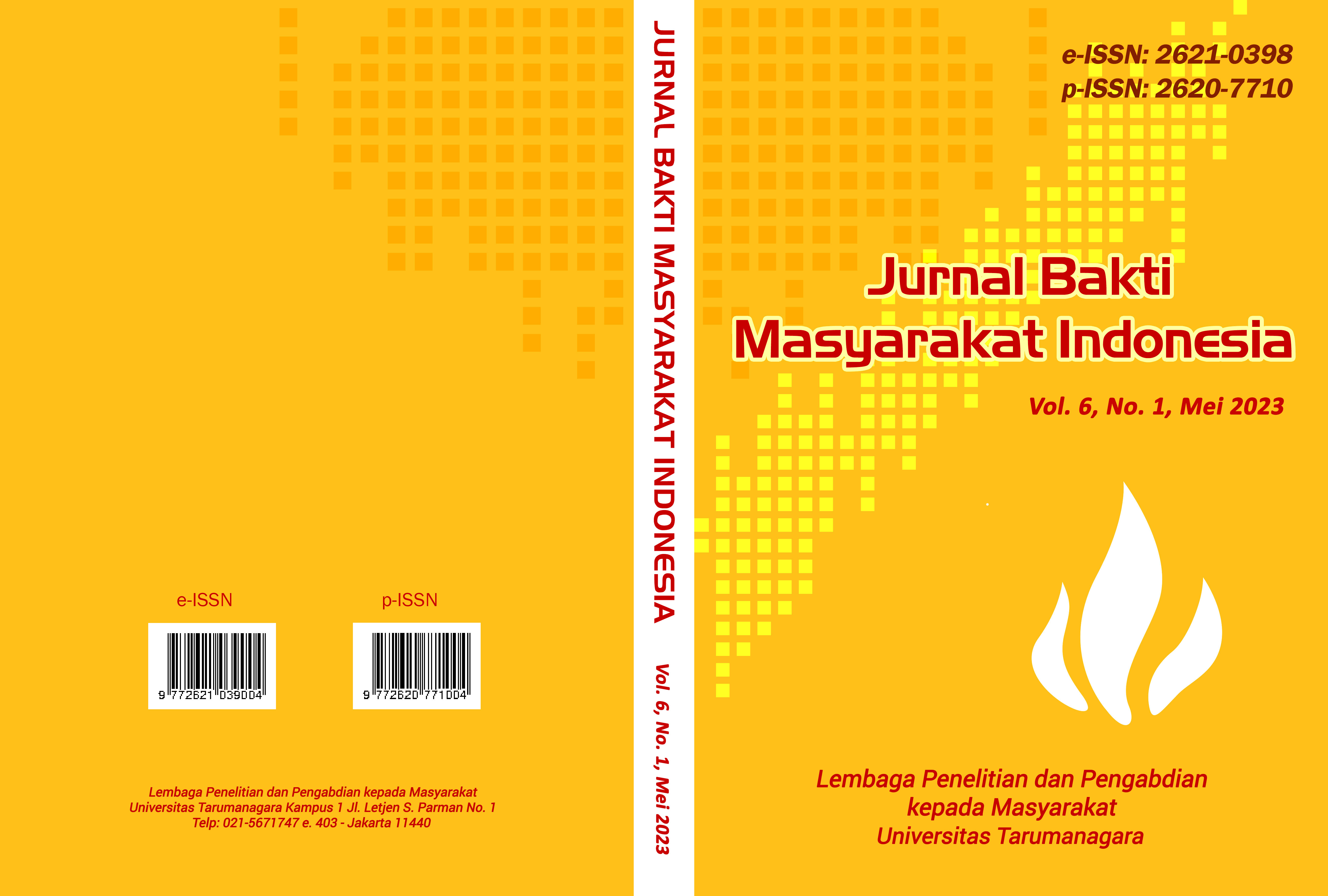SURVEI PENGUKURAN STATUS GIZI BALITA DAN POLA PEMBERIAN MAKANAN PENDAMPING ASI DI RPTRA MANDALA KELURAHAN TOMANG JAKARTA BARAT
Main Article Content
Abstract
The Environmental Community Service (PKM) activity at RPTRA Mandala, Tomang Village, West Jakarta, was carried out in June 2022 in the form of checking the nutritional status of toddlers and counseling with the aim of increasing public awareness in stunting prevention efforts. Abdimas was followed by mothers and caregivers (grandmothers/aunts) of 123 toddlers living in RW 1-16, Tomang Village. The history of infant feeding showed that 64% were exclusively breastfed, and 86% started complementary feeding at the age of 6 months, with a pattern of 78% eating regularly (3-4 times per day), and 59% consuming snacks irregularly (more than 2 times per day). Anthropometric examination found 56% of children under five with normal BW/U, 67% normal BW/U, and 54% normal BW/TB. Gender of children under five had a significant relationship with BB/TB (p=0.026; PR=1.9) but not significant for BB/U (p=0.065; PR=1.4) and TB/U (p=0.057; PR= 1,2). Exclusive breastfeeding was significantly associated with BW/U (p=0.028; PR=1.9) and BW/TB (p=0.045: PR=1.5), but not significant for TB/U (p=0.081; PR= 4.1). Timely complementary feeding showed a significant relationship with BW/U (p= 0.043; PR=3), TB/U (p<0.001; PR=2.4), and BW/TB (p=0.048; PR=1.6). Giving the main MPASI menu regularly 3-4 times per day had a significant relationship with BW/U (p=0.07; PR=4.2), but not significantly with TB/U (p=0.301; PR=1.7 ) and BB/TB (p=0,203; PR=3,3). The practice of irregular snacks, exceeding the recommendation of 1-2 times per day, showed a significant relationship with body weight (p<0.001; PR=1.1), TB/U (p<0.001; PR=2.1), and BW/TB (p=0.002; PR=2,3). Feeding infants and children is proven to determine the nutritional status of toddlers, special attention needs to be given to improving the practice of snacking for toddlers.
ABSTRAK:
Kegiatan Pengabdian Kepada Masyarakat (PKM) Lingkungan di RPTRA Mandala, Kelurahan Tomang, Jakarta
Barat, dilaksanakan pada bulan Juni 2022 dalam bentuk pemeriksaan status gizi balita dan penyuluhan dengan
tujuan peningkatan kesadaran masyarakat dalam upaya pencegahan stunting. Abdimas diikuti oleh ibu dan pengasuh
(nenek/bibi) dari 123 balita yang tinggal di RW 1-16 Kelurahan Tomang. Riwayat pemberian makan bayi
menunjukkan 64% mendapat ASI eksklusif, dan 86% mulai diberikan MPASI saat usia 6 bulan, dengan pola 78%
makan secara teratur (3-4 kali per hari), dan 59% mengonsumsi makanan selingan secara tidak teratur (lebih dari 2
kali per hari). Pemeriksaan antropometri menemukan 56% balita dengan BB/U normal, 67% TB/U normal, dan 54%
BB/TB normal. Jenis kelamin balita memiliki hubungan bermakna dengan BB/TB (p=0,026; PR=1,9) namun tidak
bermakna untuk BB/U (p=0,065; PR=1,4) dan TB/U (p=0,057; PR=1,2). ASI eksklusif berhubungan secara
bermakna dengan BB/U (p=0,028; PR=1,9) dan BB/TB (p=0,045: PR=1,5), namun tidak bermakna untuk TB/U
(p=0,081; PR=4,1). MPASI tepat waktu menunjukkan hubungan bermakna dengan BB/U (p= 0,043; PR=3), TB/U
(p<0,001; PR=2,4), dan BB/TB (p=0,048; PR=1,6). Pemberian menu MPASI utama yang teratur 3-4 kali per hari
memiliki hubungan bermakna dengan BB/U (p=0,07; PR=4,2), namun tidak bermakna dengan TB/U (p=0,301;
PR=1,7) dan BB/TB (p=0,203; PR=3,3). Praktik makanan selingan tidak teratur, melebihi rekomendasi 1-2 kali per
hari, menunjukkan hubungan bermakna dengan BB/U (p<0,001; PR=1,1), TB/U (p<0,001; PR=2,1), dan BB/TB
(p=0,002; PR=2,3). Pemberian makan bayi dan anak menentukan status gizi balita, perhatian khusus perlu diberikan
untuk perbaikan praktik makanan selingan untuk balita.
Article Details

This work is licensed under a Creative Commons Attribution-NonCommercial-ShareAlike 4.0 International License.
This work is licensed under a Jurnal Bakti Masyarakat Indonesia https://creativecommons.org/licenses/by-nc-sa/4.0/
References
Arikpo D, Edet ES, Chibuzor MT, et al. (2018). Educational interventions for improving primary caregivercomplementary feeding practices for children aged 24 months and under. Cochrane Database of Systematic Reviews, Issue 5. Art.No.: CD011768.
Badan Penelitian dan Pengembangan Kesehatan, (2019). Laporan Provinsi DKI Jakarta Riskesdas 2018. Jakarta: Lembaga Penerbit Badan Penelitian dan Pengembangan Kesehatan.
Campoya C, Camposa D, Cerdóa T, et al. (2018). Complementary Feeding in Developed Countries: The 3 Ws (When, What, and Why?). Ann Nutr Metab, 73(suppl 1):27–36.
El-Asheera OM, Shafeka MA, Abdel-Hafeza FA, et al. (2022), Growth faltering in infants – what are the underlying factors? J Curr Med Res Pract 7:17–21.
Febriana WR, Nurhaeni N. (2019) Is There Any Relationship between Feeding Practices for Children Under Two Years of Age (6–23 Months) and Stunting? Comprehensive Child and Adolescent Nursing, 42:65-72.
Paramashanti BA, Benita S. (2020). Early introduction of complementary food and childhood stunting among children aged 6-23 month. Jurnal Gizi Klinik Indonesia, 7(1):1-8.
Pratiwi R, Pramono A, Hardaningsih G. (2021) Risk factor of growth faltering in infants aged 2-12 months. Indonesian J Nut; 10{1;72-9.
Uwiringiyimana V, Ocke MC, Amer S, et al. (2019) Predictors of stunting with particular focus on complementary feeding practices: A cross-sectional study in the northern province of Rwanda Nutrition 60;11-8.
von Salmuth V, Brennan E, Kerac M, McGrath M, Frison S, Lelijveld N (2021) Maternalfocused interventions to improve infant growth and nutritional status in low-middle income countries: A systematic review of reviews. PLoS ONE 16(8): e0256188.



